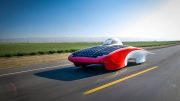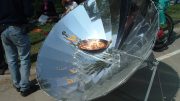The earth absorbs heat from the sun’s rays every day, but at night this solar heat radiates back into space as infrared light. By capturing some of it at night, we could have a powerful source of energy when the sun doesn’t shine.
This is exactly what Australian scientists have done by creating a groundbreaking new method for producing electricity from dissipating infrared light. Their invention lies in a semiconductor device called a thermoradiative diode, which is composed of materials used in night-vision goggles.
“Using thermal imaging cameras you can see how much radiation there is at night, but just in the infrared rather than the visible wavelengths. What we have done is make a device that can generate electrical power from the emission of infrared thermal radiation,” explains Ned Ekins-Daukes, an associate professor at the University of New South Wales in Sydney who led the research team.
“Whenever there is a flow of energy, we can convert it between different forms,” Ekins-Daukes says.
The thermoradiative process upon which the scientists have relied for their invention is similar to photovoltaics, the technology that allows us to convert sunlight into electricity by day.
“We are diverting energy flowing in the infrared from a warm Earth into the cold universe,” says Phoebe Pearce, another key member of the research team.
“In the same way that a solar cell can generate electricity by absorbing sunlight emitted from a very hot sun, the thermoradiative diode generates electricity by emitting infrared light into a colder environment. In both cases the temperature difference is what lets us generate electricity,” Pearce elucidates.
The breakthrough is the first application that harnesses what was previously a theoretical process and although the amount of power generated by the device is still 100,000 times less than the output of a solar panel, much more efficient devices in future could capture infrared energy at far larger scales.
Back in 1954, the Australian researchers note, the first silicon solar cell was only around 2% efficient, but solar panels have since come a long way with their rate of efficiency having increased by more than tenfold.
“Even if the commercialisation of these [new] technologies is still a way down the road, being at the very beginning of an evolving idea is such an exciting place to be as a researcher,” says Michael Nielsen, a lecturer at the university’s School of Photovoltaic and Renewable Energy who was a co-author of a paper on the team’s findings.
“By leveraging our knowledge of how to design and optimise solar cells and borrowing materials from the existing mid-infrared photodetector community, we hope for rapid progress towards delivering the dream of solar power at night,” Nielsen stresses.
Originally published by Sustainability Times





